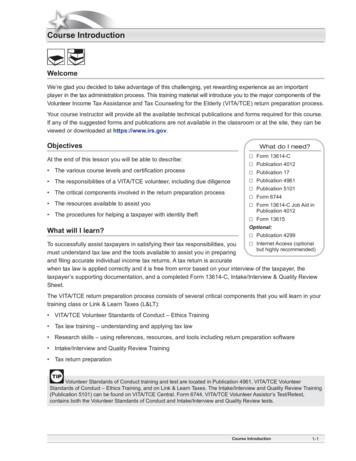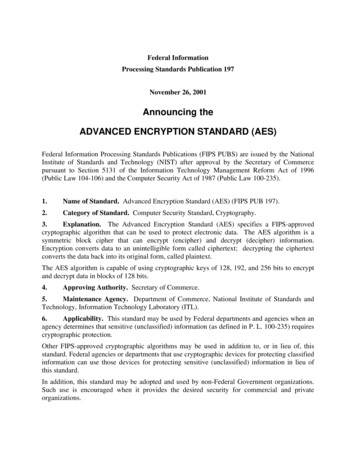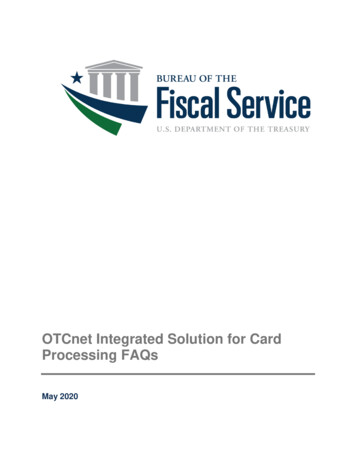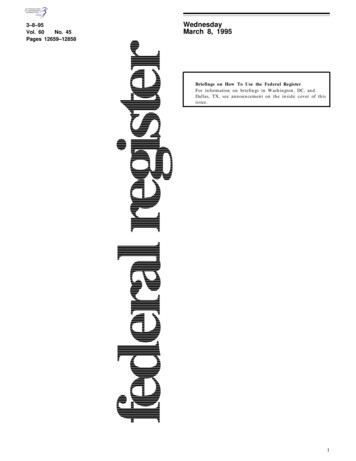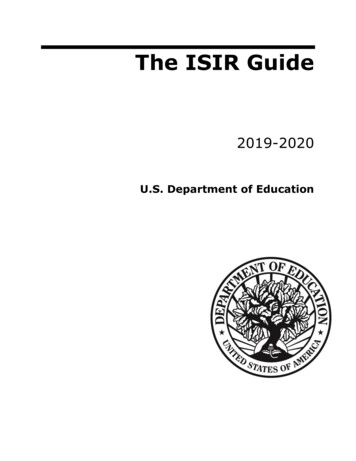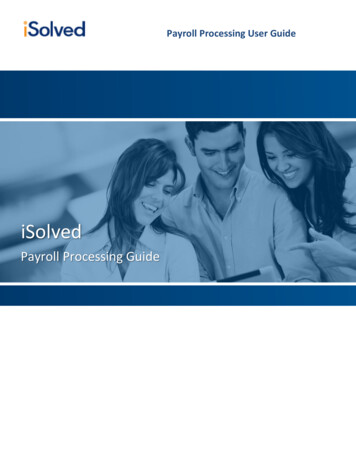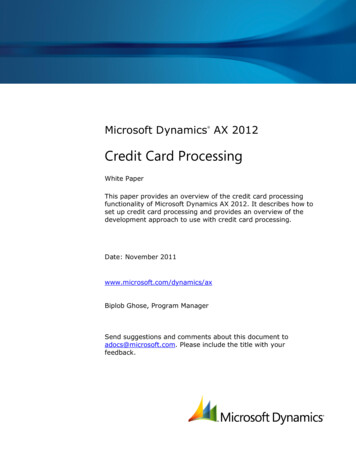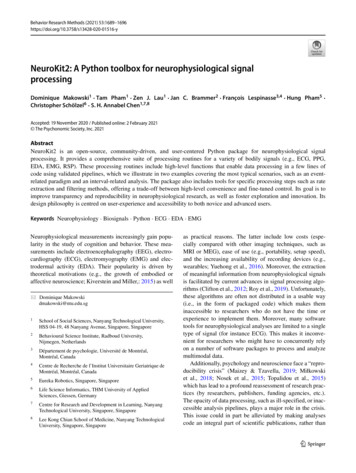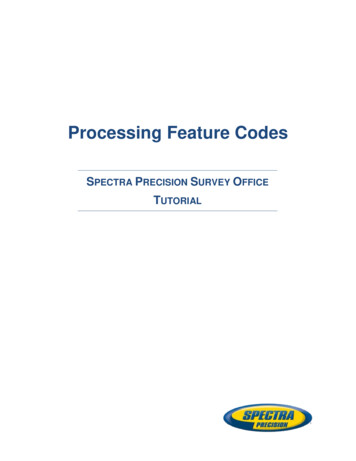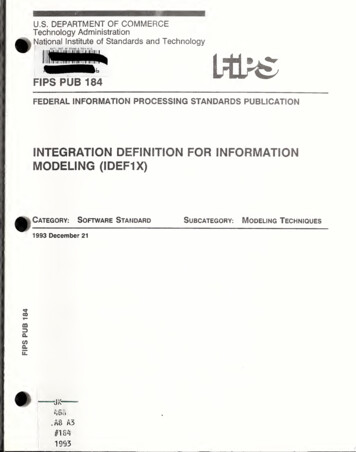
Transcription
U.S. DEPARTMENT OF COMMERCETechnology AdministrationNational Institute of Standards and TechnologyNAT L INST, OF STAND & TECH R.I.C.FIPS PUB 184FEDERAL INFORMATION PROCESSING STANDARDS PUBLICATIONINTEGRATION DEFINITION FOR INFORMATIONMODELING (IDEF1X)Category;Software StandardFIPS PUB 1841993 December 211995SUBCATEGORY:MODELING TECHNIQUES
FiPS PUB 184FEDERAL INFORMATION PROCESSING STANDARDS PUBLICATIONINTEGRATION DEFINITION FOR INFORMATIONMODELING (IDEF1X)Category:Software StandardComputer Systems LaboratoryNational Institute of Standards and TechnologyGaithersburg, MD 20899Issued December 21, 1993U.S. Department of CommerceRonald H. Brown, SecretaryTechnology AdministrationMary L. Good, Under Secretary for TechnologyNational Institute of Standardsand TechnologyArati Prabhakar, DirectorSubcategory:Modeling Techniques
ForewordThe Federal Information Processing Standards Publication Series of the NationalInstitute of Standards and Technology (NIST) is the official publication relating tostandards and guidelines adopted and promulgated under the provisions of Section111 (d) of the Federal Property and Administrative Services Act of 1949 as amended bythe Computer Security Act of 1987, Public Law 100-235. These mandates have giventhe Secretary of Commerce and NIST important responsibilities for improving theutilization and management of computer and related telecommunications systems inthe Federal Government. The NIST, through its Computer Systems Laboratory,provides leadership, technical guidance, and coordination of Government efforts in thedevelopment of standards and guidelines in these areas.Comments concerning Federal Information Processing Standards Publications arewelcomed and should be addressed to the Director, Computer Systems Laboratory,National Institute of Standards and Technology, Gaithersburg, MD 20899.James H. Burrows, DirectorComputer Systems LaboratoryAbstractThe Integration Definition for Information Modeling (IDEF1X) is based on the Inte gration Information Support System (MSS), Volume V-Common Data Model Subsys tem, Part 4-Information Modeling Manual-IDEF1 Extended, 1 (IDEF1X) November1985.This standard describes the IDEF1X modeling language (semantics and syntax)and associated rules and techniques, for developing a logical model of data. IDEF1Xis used to produce a graphical information model which represents the structure andsemantics of information within an environment or system. Use of this standard per mits the construction of semantic data models which may serve to support the man agement of data as a resource, the integration of information systems, and the buildingof computer databases.Key words; Federal Information Processing Standard (FIPS); graphical language;IDEF1X; information model; logical; model; semantic data model; system information.National Institute of Standardsand TechnologyFIPS PUB 184161 pages (Dec. 21, 1993)CODEN: FIPPATU.S. Government Printing OfficeWashington: 1993For sale by the NationalTechnical InformationServiceU.S. Department of CommerceSpringfield, VA 22161
FIPS PUB 184Federal InformationProcessing Standards Publication 1841993 December 21Announcing the Standard forINTEGRATION DEFINITION FOR INFORMATIONMODELING (IDEF1X)Federal Information Processing Standards Publications (FIPS PUBS) are issued by the National Institute of Standards andTechnology (NIST) after approval by the Secretary of Commerce pursuant to Section 111 (d) of the Federal Property and Administra tive Services Act of 1949 as amended by the Computer Security Act of 1987, Public Law 100-235.1.Name of Standard.Integration Definition for Information Modeling (IDEF1X).2.Category of Standard.Software Standard, Modeling Techniques.3. Explanation. This publication announces the adoption of the Integration Definition for InformationModeling (IDEF1X) as a Federal Information Processing Standard (FIPS). This standard is based on theIntegration Information Support System (lISS), Volume V—Common Data Model Subsystem, Part 4Information Modeling Manual-IDEF1 Extended, 1 (IDEF1X) November 1985.This standard describes the IDEF1X modeling language (semantics and syntax) and associated rulesand techniques, for developing a logical model of data. IDEF1X is used to produce a graphical informationmodel which represents the structure and semantics of information within an environment or system. Useof this standard permits the construction of semantic data models which may serve to support the manage ment of data as a resource, the integration of information systems, and the building of computer databases.This standard is the reference authority for use by information modelers required to utilize the IDEF1Xmodeling technique, implementors in developing tools for implementing this technique, and other com puter professionals in understanding the precise syntactic and semantic rules of the standard.4.Approving Authority.Secretary of Commerce.5. Maintenance Agency. Department of Commerce, National Institute of Standards and Technology,Computer Systems Laboratory.6.Cross Index.a. Integration Information Support System (lISS), Volume V-Common Data Model Subsystem, Part4-Information Modeling Manual —IDEF1 Extended.7.Related Documents.a. Federal Information Resources Management Regulations Subpart 201.20.303, Standards, andSubpart 201.39.1002, Federal Standards.b. ICAM Architecture Part II, Volume V—Information Modeling Manual (IDEF1), AFWAL-TR-81-4023,Materials Laboratory, Air Force Wright Aeronautical Laboratories, Air Force Systems Command, WrightPatterson Air Force Base, Ohio 45433, June 1981.c. ICAM Architecture Part II, Volume IV-Function Modeling Manual (IDEFO), AFWAL-TR-81-4023,Materials Laboratory, Air Force Wright Aeronautical Laboratories, Air Force Systems Command, WrightPatterson Air Force Base, Ohio 45433, June 1981.d. ICAM Configuration Management, Volume II - ICAM Documentation Standards for Systems Devel opment Methodology (SDM), AFWAL-TR-82-4157, Air Force Systems Command, Wright-Patterson AirForce Base, Ohio 45433, October 1983.1
FIPS PUB 1848.Objectives. The primary objectives of this standard are:a.To provide a means for completely understanding and analyzing an organization’s data resources:b.To provide a common means of representing and communicating the complexity of data;c.To provide a technique for presenting an overall view of the data required to run an enterprise;d.To provide a means for defining an application-independent view of data which can be validatedby users and transformed into a physical database design;e.To provide a technique for deriving an integrated data definition from existing data resources.9. Applicability. An information modeling technique is used to model data in a standard, consistent,predictable manner in order to manage it as a resource.The use of this standard is strongly recommended for all projects requiring a standard means of defin ing and analyzing the data resources within an organization. Such projects include:a.incorporating a data modeling technique into a methodology:b.using a data modeling technique to manage data as a resource;c.using a data modeling technique for the integration of information systems;d.using a data modeling technique for designing computer databases.The specifications of this standard are applicable when a data modeling technique is applied to thefollowing:a.projects requiring IDEF1X as the modeling technique;b.development of automated software tools implementing the IDEF1X modeling technique.The specification of this standard are not applicable to those projects requiring data modeling tech nique other than IDEF1X.Nonstandard features of the IDEF1X technique should be used only when the needed operation orfunction cannot reasonably be implemented with the standard features alone. Although nonstandard fea tures can be very useful, it should be recognized that the use of these or any other nonstandard elementsmay make the integration of data models more difficult and costly.10. Specifications. This standard adopts the Integration Definition Method for Information Modeling(IDEF1X) as a Federal Information Processing Standard (FIPS).11. implementation. The implementation of this standard involves two areas of consideration; acquisi tion of implementations and interpretation of the standard.11.1 Acquisition of IDEF1X Implementations. This publication (FIPS 184) is effective June 30,1994. Projects utilizing the IDEF1X data modeling technique, or software implementing the IDEF1X datamodeling technique, acquired for Federal use after this date should conform to FIPS 184. Conformance tothis standard should be considered whether the project utilizing the IDEF1X data modeling technique isacquired as part of an ADP system procurement, acquired by separate procurement, used under an ADPleasing arrangement, or specified for use in contracts for programming services.A transition period provides time for industry to develop products conforming to this standard. Thetransition period begins on the effective date and continues for one (1) year thereafter. The provisions ofthis publication apply to orders placed after the date of this publication; however, utilizing an IDEF1X infor mation modeling technique that does not conform to this standard may be permitted during the transitionperiod.2
FIPS PUB 18411.2 Interpretation of this FIPS. NIST provides for the resolution of questions regarding the imple mentation and applicability of this FIPS. All questions concerning the interpretation of IDEF1X should beaddressed to;Director, Computer Systems LaboratoryATTN: FIPS 184 InterpretationNational Institute of Standards and TechnologyGaithersburg, MD 2089912. Waivers. Under certain exceptional circumstances, the heads of Federal departments and agenciesmay approve waivers to Federal Information Processing Standards (FIPS). The head of such agencies mayredelegate such authority only to a senior official designated pursuant to section 3506(b) of Title 44, UnitedStates Code. Requests for waivers shall be granted only when:a.Compliance with a standard would adversely affect the accomplishment of the mission of an oper ator of a Federal computer system, orb.Compliance with a standard would cause a major adverse financial impact on the operator whichis not offset by government-wide savings.Agency heads may approve requests for waivers only by a written decision which explains the basisupon which the agency head made the required finding(s). A copy of each such decision, with procurementsensitive or classified portions clearly identified, shall be sent to:Director, Computer Systems LaboratoryATTN; FIPS Waiver DecisionsTechnology Building, Room B-154National Institute of Standards and TechnologyGaithersburg, MD 20899.In addition, notice of each waiver granted and each delegation of authority to approve waivers shall besent promptly to the Committee on Government Operations of the House of Representatives and the Com mittee on Governmental Affairs of the Senate and shall be published promptly in the Federal Register.When the determination on a waiver request applies to the procurement of equipment and/or services,a notice of the waiver determination must be published in the Commerce Business Daily as a part of thenotice of solicitation for offers of an acquisition or, if the waiver determination is made after that notice ispublished, by amendment of such notice.A copy of the waiver request, any supporting documents, the document approving the waiver requestand any supporting and accompanying documents, with such deletions as the agency is authorized anddecides to make under 5 U.S.C. Sec. 552 (b), shall be part of the procurement documentation and retainedby the agency.13. Where to Obtain Copies. Copies of this publication are for sale by the National Technical Informa tion Service, U.S. Department of Commerce, Springfield, VA 22161. When ordering, refer to FederalInformation Processing Standards Publication 184 (FIPSPUB184) and title. Payment may be made bycheck, money order, or deposit account.3
o
Federal InformationProcessing Standards Publication 184Specification forIntegration Definition for Information Modeling(IDEFIX)
Background:The need for semantic data models was first recognized by the U.S. Air Force in themid-seventies as a result of the Integrated Computer Aided Manufacturing (ICAM)Program. The objective of this program was to increase manufacturing productivitythrough the systematic application of computer technology. The ICAM Programidentified a need for better analysis and communication techniques for people involved inimproving manufacturing productivity. As a result, the ICAM Program developed aseries of techniques known as the IDEF (ICAM Definition) Methods which included thefollowing:a) IDEFO used to produce a “function model” which is a structured representation ofthe activities or processes within the environment or system.b) IDEFl used to produce an “information model” which represents the structure andsemantics of information within the environment or system.c) IDEF2 used to produce a “dynamics model” which represents the time varyingbehavioral characteristics of the environment or system.The initial approach to IDEF information modeling (IDEFl) was published by the ICAMprogram in 1981, based on current research and industry needs. The theoretical roots forthis approach stemmed from the early work of Dr. E. F. Codd on relational theory and Dr.P. P. S. Chen on the entity-relationship model. The initial IDEFl technique was based onthe work of Dr. R. R. Brown and Mr. T. L. Ramey of Hughes Aircraft and Mr. D. S.Coleman of D. Appleton Company, with critical review and influence by Mr. C. W.Bachman, Dr. P. P. S. Chen, Dr. M. A. Melkanoff, and Dr. G. M. Nijssen.In 1983, the U.S. Air Force initiated the Integrated Information Support System (US )project under the ICAM program. The objective of this project was to provide theenabling technology to logically and physically integrate a network of heterogeneouscomputer hardware and so are. As a result of this project, and industry experience, theneed for an enhanced technique for information modeling was recognized.Application within industry had led to the development in 1982 of a Logical DatabaseDesign Technique (LDDT) by R. G. Brown of the Database Design Group. Thetechnique was based on the relational model of Dr. E. F. Codd, the entity-relationshipmodel of Dr. P. P. S. Chen, and the generalization concepts of J. M. Smith and D. C. P.Smith. It provided multiple levels of models and a set of graphics for representing theconceptual view of information within an enterprise. LDDT had a high degree of overlapwith IDEFl features, introduced enhanced semantic and graphical constructs, andaddressed information modeling enhancement requirements identified under the PS program. Under the technical leadership of Dr. M. E. S. Loomis of D. AppletonCompany, a substantial subset of LDDT was combined with the methodology of IDEFl,and published by the ICAM program in 1985. This technique was called IDEFlExtended or, simply, IDEFIX.A principal objective of IDEFIX is to support integration. The PS approach tointegration focuses on the capture, management, and use of a single semantic definitionof the data resource referred to as a “Conceptual Schema.” The “conceptual schema”provides a single integrated definition of the data within an enterprise which is unbiasedtoward any single application of data and is independent of how the data is physicallystored or accessed. The primary objective of this conceptual schema is to provide aconsistent definition of the meanings and interrelationship of data which can be used to1
integrate, share, and manage the integrity of data. A conceptual schema must have threeimportant characteristics:a) It must be consistent with the infrastructure of the business and be true across allapplication areas.b) It must be extendible, such that, new data can be defined without alteringpreviously defined data.c) It must be transformable to both the required user views and to a variety of datastorage and access structures.The IDEFIX approach:IDEFIX is the semantic data modeling technique described by this document.IDEFIX technique was developed to meet the following requirements:The1) Support the development of conceptual schemas.The IDEFIX syntax supports the semantic constructs necessary in thedevelopment of a conceptual schema. A fully developed IDEFIX model has thedesired characteristics of being consistent, extensible, and transformable.2) Be a coherent language.IDEFIX has a simple, clean consistent structure with distinct semantic concepts.The syntax and semantics of IDEFIX are relatively easy for users to grasp, yetpowerful and robust.3) Be teachable.Semantic data modeling is a new concept for many IDEFIX users. Therefore, theteachability of the language was an important consideration. The language isdesigned to be taught to and used by business professionals and system analysts aswell as data administrators and database designers. Thus, it can serve as aneffective communication tool across interdisciphnary teams.4) Be well-tested and proven.IDEFIX is based on years of experience with predecessor techniques and hasbeen thoroughly tested both in i r Force development projects and in privateindustry.5) Be automatable.IDEFIX diagrams can be generated by a variety of graphics packages. Inaddition, an active three-schema dictionary has been developed by the Air Forcewhich uses the resulting conceptual schema for an application development andtransaction processing in a distributed heterogeneous environment. Commercialsoftware is also available which supports the refinement, analysis, andconfiguration management of IDEFIX models.
The basic constructs of an EDEFIX model are:1) Things about which data is kept, e.g., people, places, ideas, events, etc.,represented by a box;2) Relationships between those things, represented by lines connecting the boxes;and3) Characteristics of those things represented by attribute names within the box.
Table of Contents1. Overview.11.1 Scope.11.2 Purpose.12. Definitions.23. EDEFIX Syntax and Semantics.73.1 Entities.73.1.1 Entity Semantics.73.1.2 Entity Syntax.83.1.3 Entity Rules.93.2 Domains.93.2.1 Domain Semantics.93.2.2 Domain Syntax.113.2.3 Domain Rules.113.3 Views.123.3.1 View Semantics.123.3.2 View Syntax.123.3.3 View Rules.123.4 Attributes.123.4.1 Attribute Semantics.133.4.2 Attribute Syntax.133.4.3 Attribute Rules.143.5 Connection Relationships.153.5.1 Specific Connection Relationship Semantics.153.5.1.1 Identifying Relationship Semantics .163.5.1.2 Non-Identifying Relationship Semantics.163.5.2 Specific Connection Relationship Syntax.163.5.2.1 Identifying Relationship Syntax .173.5.2.2 Non-Identifying Relationship Syntax.173.5.2.3 Mandatory Non-Identifying Relationship Syntax.183.5.2.4 Optional Non-Identifying Relationship Syntax.183.5.3 Specific Connection Relationship Label.193.5.4 Specific Connection Relationship Rules.203.6 Categorization Relationships.203.6.1 Categorization Relationship Semantics.203.6.2 Categorization Relationship Syntax.213.6.3 Categorization Relationship Rules.233.7 Non-Specific Relationships.233.7.1 Non-Specific Relationship Semantics.233.7.2 Non-Specific Relationship Syntax.243.7.3 Non-Specific Relationship Rules.253.8 Primary and Alternate Keys.253.8.1 Primary and Alternate Key Semantics.263.8.2 Primary and Alternate Key Syntax.263.8.3 Primary and Alternate Key Rules.273.9 Foreign Keys.273.9.1 Foreign Key Semantics.273.9.1.1 Role Name Semantics.283.9.2 Foreign Key Syntax.283.9.2.1 Role Name Syntax.293.9.3 Foreign Key Rules.303.10 View Levels.313.10.1 View Level Semantics.313.10.2 View Level Syntax.32IV
3.10.3 View Level Rules.323.11 View Presentation.333.12 Glossary.333.13 Model Notes.343.13.1 Model Note Rules.353.14 Lexical Conventions.353.14.1 View, Entity, and Domain (Attribute) Names.353.14.2 Entity Labels.363.14.3 Role Name Attribute Labels.363.14.4 Relationship Names and Labels.373.14.5 Model Notes.373.14.6 Displaying Labels on More Than One Line.384. Bibliography.39Annex A. Concepts and Procedures from the Original ICAM Work.40Al. Definitions.40A2. Data Modeling Concepts.42A2.1 Managing Data as a Resource.42A2.2 The Three Schema Concept.43A2.3 Objectives of Data Modeling.45A2.4 The IDEE IX Approach.46A3. Modeling Guidelines.48A3.1 Phase Zero — Project Initiation.48A3.1.1 Establish Modeling Objectives.48A3.1.2 Develop Modeling Plan.49A3.1.3 Organize Team.49A3.1.4 Collect Source Material.54A3.1.5 Adopt Author Conventions.55A3.2 Phase One - Entity Definition.56A3.2.1 Identify Entities.56A3.2.2 Define Entities.58A3.3 Phase Two - Relationship Definition.59A3.3.1 Identify Related Entities.60A3.3.2 Define Relationships.61A3.3.3 Construct Entity-Level Diagrams.63A3.4 Phase Three - Key Definitions.66A3.4.1 Resolve Non-Specific Relationships.67A3.4.2 Depict Function Views.68A3.4.3 Identify Key Attributes .69A3.4.4 Migrate Primary Keys.72A3.4.5 Validate Keys and Relationships.75A3.4.6 Define Key Attributes.80A3.4.7 Depict Phase Three Results.81A3.5 Phase Four - Attribute Definition.83A3.5.1 Identify Nonkey Attributes.83A3.5.2 Establish Attribute Ownership .83A3.5.3 Define Attributes.85A3.5.4 Refine Model.85A3.5.5 Depict Phase Four Results.87V
A4. Documentation and Validation.89A4.1 Introduction.89A4.2 IDEFIX Kits.89A4.3 Standard Forms.91A4.4 The LDEF Model Walk-Through Procedure.96Annex B Formalization.100B.l Introduction.100B.l.l Objectives.100B.1.2 Overview.100B. 1.2.1 An IDEFIX Theory.100B.1.2.2 An IDEFIX Meta Model.103B.1.3 Example.103B. 1.3.1 Diagram.104B. 1.3.2 Domains.105B. 1.3.3 Sample Instances.106B.1.4 First Order Language.108B.l.4.1 Truth Symbols.108B. 1.4.2 Constant Symbols.108B. 1.4.3 Variable Symbols.109B. 1.4.4 Function Symbols.109B. 1.4.5 Terms.109B. 1.4.6 Predicate Symbols.109B. 1.4.7 Equality Symbol.109B. 1.4.8 Propositions.109B. 1.4.9 Sentences.109B.1.4.10 Incremental Definitions.110B.2 Generating an IDEFIX Theory From an IDEFIX Model.112B.3 Vocabulary of an IDEFIX Theory.113B 3.1 Constant Symbols.113B.3.1.1 Constants Common To All IDEFIX Theories.113B.3.1.2 Constants Determined By The IDEFIX Model.113B.3.2 Function Symbols.113B.3.2.1 Naming.113B.3.2.2 List Constructor.114B.3.2.3 Addition.114B3.3 Predicate Symbols.114B.3.3.1 Predicate Symbols Common To All IDEFIX Theories.114B.3.3.2 Predicate Symbols Determined By The IDEFIX Model.117B.4 Axioms of an IDEFIX Theory.118B.4.1 Axioms Common To All IDEFIX Theories.118B.4.1.1 Non-Negative Integers.118B.4.1.2 Lists.118B.4.1.3 Equality.118B.4.1.4 Unique Naming.118B.4.1.5 Atoms.118B.4.1.6 Entity Identity.118B.4.1.7 Domain Referencing.119B.4.1.8 Domain Value.119B.4.1.9 Attribute Domain.119B.4.1.10 Category Inheritance.120VI
B.4.2 Axioms Determined By The IDEFIX Model.120B.4.2.1 Glossary.120B.4.2.2 Entity.121B.4.2.3 Domain.121B.4.2.4 Attribute.123B.4.2.5 Specific Connection Relationship.124B.4.2.6 Non-Specific Relationship.127B.4.2.7 Categorization Relationship.127B.4.2.8 Primary and Alternate Key.129B.4.2.9 Foreign Key.130B.4.2.10 Constraints as Axioms.132B.4.2.11 Distinct Atomic Constants.132B.5 IDEFIX Meta Model.133B.5.1 IDEFIX Diagram.134B.5.2 Domains.135B.5.3 Constraints.136B.5.3.1 Acyclic Generalization.136B.5.3.2 Acyclic Domain Type and Alias.136B.5.3.3 Acyclic Entity Alias.137B.5.3.4 An Alias Domain Cannot Have a Domain Rule .137B.5.3.5 An Entity in a View Can Be Known By Only One Name.137B.5.3.6 An Attribute in a View Can Be Known By Only OneName.138B.5.3.7 ER View Entity Attribute Constraints.138B.5.3.8 DiscEntity is Generic or an Ancestor of Generic.138B.5.3.9 A Complete Cluster Cannot Have an OptionalDiscriminator.139B.5.3.10 Primary Key Constraints.139B.5.3.11 ER Connection Constraints.140B.5.3.12 Connection is Specific If Level is not ER.141B.5.3.13 View Entity Is Dependent.141B.5.3.14 Migrated Attribute.141B.5.3.15 An Attribute is Owned Iff It Is Not Migrated.141B.5.3.16 An Attribute Can Be Owned by At Most One Entity in aView.142B.5.3.17 Non ER Connection Cardinality Constraints.142B.5.3.18 Low Cardinality Is Less Than Or Equal To HighCardinality.142B.5.3.19 Child Cardinality is Z or 1 Iff Roles Contain the PrimaryKey or Any Alternate Key.143B.5.3.20 Is-Mandatory is True Iff All Roles Are Nonull.143B.5.3.21 Connection with Foreign Keys is Identifying Iff theForeign Key Attributes Are a Subset of the ChildPrimary Key.143B.5.3.22 Foreign Key Attributes Determine ConnectionNo.144B.5.3.23 Connection Foreign Key Attributes Type UniquelyOnto Parent Primary Key Attributes.144B.5.3.24 Category Primary Key Attributes Type Uniquely OntoGeneric Primary Key Attributes.145B.5.4 Valid IDEFIX Model.146B.6 Bibliography.147B.7 Acknowledgements.147vii
1. OverviewThis standard describes the IDEFIX modeling language (semantics and syntax) andassociated rules and techniques, for developing a logical model of data. IDEFIX is usedto produce information models which represent the structure and semantics ofinformation within an enterprise.1.1 ScopeIDEFIX is used to produce a graphical information model which represents the structureand semantics of information within an environment or system. Use of this standardpermits the construction of semantic data models which may serve to support themanagement of data as a resource, the integration of information systems, and thebuilding of computer databases.In addition to the standard specification, this document provides two informativeannexes. Annex A provides an example of a process of developing an IDEFIX modelintroduced in the original ICAM program. Annex B introduces a fomalization to theIDEFIX language written by R. G. Brown of the Database Design Group.1.2 PurposeThis information modeling technique is used to model data in a standard, consistent,predictable manner in order to manage it as a resource. The primary objectives of thisstandard are:a) To provide a means for completely understanding and analyzing an organization’sdata resources;b) To provide a common means of representing and communicating the complexity ofdata;c) To provide a method for presenting an overall view of the data required to run anenterprise;d) To provide a means for defining an application-independent view of data whichcan be validated by users and transformed into a physical database design;e) To provide a method for deriving an integrated data definition from existing dataresources.1
2. Definitions2.1 Alias: A nonstandard name for an entity or domain (attribute).2.2 Assertion: A statement that specifies a condition that must be true.2.3 Attribute: A property or characteristic that is common to some or all of the instancesof an entity. An attribute represents the use of a domain in the context of an entity.2.4 Attribute, Inherited: An attribute that is a characteristic of a category entity byvirtue of being an attribute in its generic entity or a generic ancestor entity.2.5 Attribute, Migrated: A foreign key attribute of a child entity.2.6 Attribute, Non-key: An attribute that is not the primary or a part of a compositeprimary key of an entity. A non-key attribute may be a foreign key or alternate keyattribute.2.7 Attribute, Optional: A non-key attribute of an entity that may be null in any instanceof the entity.2.8 Attribute, Owned: An attribute of an entity that has not migrated into the entity.2.9 Attribute Value: A value given to an attribute in an entity instance.2.10 Category Cluster: A set of one or more mutually exclusive categorizationrelationships for the same generic entity.2.11 Category Discriminator: An attribute in the generic entity (or a generic ancestorentity) of a category cluster. The values of the discriminator indicate which categoryentity in the category cluster contains a specific instance of the generic entity. Allinstances of the generic entity with the same discriminator value are instances of the samecategory entity. The inverse is also true.2.12 Conceptual Schema: See Schema2.13 Constraint: A rule that specifies a valid condition of data.2.14 Constraint, Cardinality: A limit on the number of entity instances that can beassociated with each other in a relationship.2.15 Constraint, Existence: A condition where an instance of one entity cannot existunless an instance of another related entity also exists.2.16 Database: A collection of interrelated data, often with controlled redundancy,organized according to a schema to serve one or more applications.2.17 Data Model: A graphical and textual representation of analysis that identifies thedata needed by an organization to achieve its mission, functions, goals, objectives, andstrategies and to manage and rate the organization. A data model identifies the entities,domains(attributes), and relationships (or associations) with other data, and provides theconceptual view of the data and the relationships among data.2
2.18 Data Type: A categorization of an abstract set of possible values, characteristics,and set of operations for an attribute. Integers, real numbers, character strings, andenumerations are examples of data types.2.19 Domain: A named set of data values (fixed, or possibly infinite in number) all of thesame data type, upon which the actual value for an attribute instance is drawn. Everyattribute must be defined on exactly one underlying domain. Multiple attributes may bebased on the same underlying domain.2.20 Enterprise: An organization that exists to perform a specific mission and achieveassociated goals and objectives.2.21 Entity: The representation of a set of real or abstract things (people, objects, places,events, ideas, combination of things, etc.) that are recognized as the same type becausethey share the same characteristics and can participate in the same relationships.2.22 Entity, Category: An entity whose instances represent a sub-type or subcl
b. using a data modeling technique to manage data as a resource; c. using a data modeling technique for the integration of information systems; d. using a data modeling technique for designing computer databases. The specifications of this standard are applicable when a data modeling technique is applied to the following:
